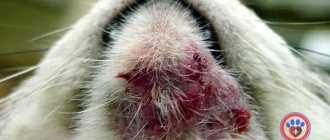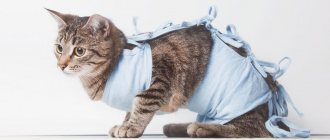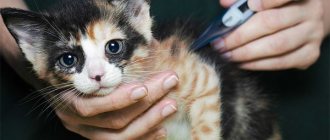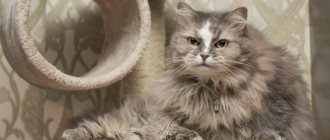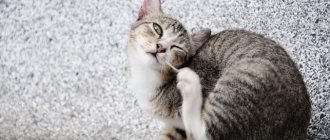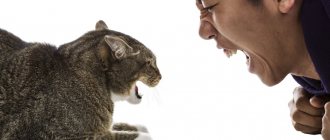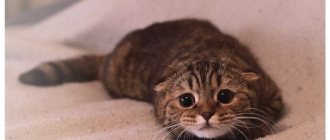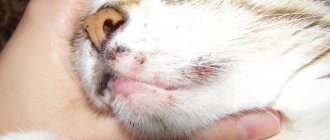Pet owners do not always understand their behavior, so the situation when a cat eats poorly, constantly sleeps, and looks lethargic is cause for concern. Should we sound the alarm? And, if so, in what cases? This article talks about this.
The cat constantly sleeps and is lethargic: normal or pathological
Long rest and lack of appetite to a certain extent are normal. If the cat has had a heavy dinner, he becomes drowsy. The normal duration of rest per day is 12-14 hours or more.
The cat does not have sweat glands, and cooling through an open mouth is not typical. Therefore, in hot weather, the pet protects itself from overheating by reducing muscle activity, and also stops consuming calories through food. A fruitful mating has a calming effect on the female, and she prefers to sleep.
At the beginning of pregnancy, a cat, like a woman, experiences toxicosis while the signs are still invisible. Protection against illness is fasting and sleep. In older pets and individuals with a phlegmatic psyche, idleness and poor appetite are normal.
The norm is considered to be drug-induced inhibition after taking sedatives or antihistamines, as well as the condition after surgery.
The cat owner should be alert to additional symptoms:
- the desire to hide in a dark corner;
- the pet stops licking itself or does it too often;
- diarrhea and (or) vomiting develops;
- shortness of breath, cough, discharge from the nose or eyes occurs;
- muscle tremors appear;
- increase in body temperature or drop below normal;
- gums lose color.
Be sure to read: One eye of a cat is watering: reasons, what to do at home, medications and folk methods
If starvation and lethargy continue for more than two days, you need to see a veterinarian. Lack of appetite accompanied by cessation of drinking is a dangerous symptom.
Loss of coordination in a cat
This may manifest itself in one of the options described below, although most often they complement each other:
- trembling and/or sudden angular movements. The entire body or individual parts (head, paws) can be involved. It usually appears when the pet is trying to concentrate on some task (eating, changing direction);
- lack of control over the body. The cat can move straight ahead quite well, but is incapable of any sudden change of direction (jump, turn, descent or ascent). In more severe cases, the pet is powerless to reproduce the sequence of the simplest movements, staggering and falling even while remaining in place;
- poor spatial orientation. The animal is unable to correctly calculate the distance to objects, constantly bumping into them.
Signs of poor appetite
If an animal sometimes refuses to eat, then there is nothing wrong with that. You may not always notice weight loss right away. Cats that live indoors need less food. Therefore, they may sometimes not feel hungry and drink only water.
Loss of appetite may be a sign of serious problems
Veterinarians identify several thinness indices. When exhausted, the animal's ribs clearly appear; if you look at it from above, its figure will resemble an hourglass. The stomach is strongly retracted.
If the cat is underweight, the ribs and spine will be clearly palpable, and there will be no fat layer. With normal weight, the animal looks like an even rectangle from above. The ribs can be felt during normal examination, but a small amount of fat will be felt.
Important! Being overweight is just as dangerous as being underweight.
The owner should only start to worry if the cat is emaciated or underweight. In this case, it is better to consult a veterinarian to determine the cause of the weight loss.
Sometimes the condition is accompanied by additional symptoms - vomiting, drowsiness, lethargy. All this may indicate the development of a serious illness. A particularly dangerous sign is refusal of water.
Video - ataxia in a cat
The nervous system is the most important for the body, as it controls absolutely all processes occurring in it. With its lesions, a wide variety of effects can be observed, often combined with the term ataxia. This pathology may well occur in cats.
Without going into details, this is the name for a set of symptoms that imply problems with coordination of movements and body position in space. There are three types of this pathology:
- Cerebellar ataxia in cats is caused by damage to the cerebellum.
- Accordingly, vestibular occurs in cases where something is very wrong with the vestibular apparatus located in the inner ear.
- Sensitive. In some ways it is similar to the cerebellar, only in this case important nerve cords are damaged.
There are different causes of ataxia in cats. Most often, the development of the disease is due to:
- Poisoning with various poisons.
- Hereditary diseases accompanied by degenerative phenomena in the nervous tissue.
- Injuries that occur especially often in March, when loving cats fall from balconies.
- Lack of vitamin B1. This is generally typical for cats: many owners “pamper” them with fresh river fish, which contains the enzyme thiaminase. It destroys thiamine, that is, B1, resulting in ataxia. This is especially noticeable in kittens.
- If the cat is “hooked” on some plants. For example, a large dose of catnip can send a cat into “nirvana” for several minutes. At this time, the pet looks like an inveterate drunkard.
- Infection. In particular, the feline is very dangerous.
- or cerebral edema.
We invite you to familiarize yourself with 17 pictures of Tibetan mastiffs, which contain 60 kilograms of fur, love and charm (18 photos)
The cat is lethargic and sleeps all the time: what is the reason?
Among the pathological causes of lethargy are the following:
- poisoning,
- hormonal disorders after childbirth or as a result of using contraceptives,
- side effects of corticosteroid anti-inflammatory drugs,
- musculoskeletal pathologies,
- infectious diseases,
- worms;
- anemia;
- hypovitaminosis;
- tumors;
- chronic diseases.
Stress causes ambivalence in cats. The pet may become sleepy or, conversely, show aggression.
Types of nystagmus in cats
There are two types of nystagmus - jerking and pendulum. Jerk (jerk) is characterized by slow eye movements in one direction, and then a sharp return to the previous state. With pendulum nystagmus, slight fluctuations of the pupils occur, in which the eyeball almost does not move. However, the jerk type is much more common in veterinary practice.
There is another classification of nystagmus - horizontal and vertical (according to the plane of eye oscillation). The vertical type occurs only with deep brain lesions and is a minor symptom. In other disorders of the nervous system, the most common is the horizontal type.
There is one more important circumstance. So-called congenital nystagmus often occurs in Siamese cats. In most cases, this is not a pathology, but a normal physiological reaction that allows you to adapt to the environment. The same can be observed in people who have overloaded their vestibular apparatus (see below).
What diseases have lethargy as a symptom?
Poisoning
Most often, veterinarians encounter lethargy in poisoned cats. An animal can become poisoned either while walking on the street or at home (for example, from chocolate).
If a cat is poisoned, it may also experience the following symptoms: vomiting, diarrhea, increased salivation, shortness of breath, unsteady gait, swollen tongue, restlessness, oral burns, tremors, convulsions or coughing.
If you think your cat's lethargy is due to poisoning, you should take her to the vet immediately.
Other
Lethargy is a symptom of most diseases, for example:
- renal failure; — feline immunodeficiency virus; — feline leukemia virus; — hypothyroidism (decreased activity of the thyroid gland); — Lyme disease; - dirofilariasis of the heart; - anemia; - diabetes; - liver diseases; - problems with blood pressure; — infectious peritonitis of cats; - bile spillage; - cancer; - purulent endometritis; - sometimes - a cold or allergy.
Since lethargy is not a disease, but only a symptom, the disease itself should be treated.
Articles on the same topic:
Why do cats sleep a lot? Can cats eat salty food? What should not be in cat food? Does a cat feel pain during childbirth? Does a cat grow a mustache?
Treatment of ataxia in cats
In the case of a genetic cause, only death is possible. Most often, veterinarians offer timely care without waiting for complications to occur (constant headaches, attacks with loss of consciousness, spasms, inability to feed independently).
If the cause is traumatic or tumor, then the chances of a long life are more realistic and largely depend on early diagnosis. Most often, antispasmodic and sedative drugs and B vitamins are prescribed. Surgical intervention is possible.
It should be remembered that even in case of recovery, the cat will no longer be the same, since brain injuries never go away without a trace, and the owner needs to be prepared for the fact that the animal may be left with limited capabilities.
If the cat is lethargic, does not eat or drink: what to do?
If the animal does not eat or drink, then there is a reason that causes vomiting. If toxic substances appear in the gastrointestinal tract, the body gets rid of them, first of all, through diarrhea and vomiting. This scenario develops in case of poisoning or infectious diseases.
When the intestinal lumen is clogged with bones, hairballs, and helminth balls, there is only one way to get rid of poisons - through the mouth. An attempt to eat or drink something is stopped reflexively and vomiting occurs. Therefore, food and water intake is stopped.
When your pet is not eating or drinking and an appointment with the veterinarian is postponed, it is necessary to protect him from dehydration. The owner of the cat is able to independently inject him with Ringer-Locke solution or saline solution subcutaneously in unlimited quantities. Use syringes of 5 or 10 ml. After the injection, an accumulation of fluid is formed, which quickly resolves. Water should not be used for injection, it causes pain.
You should not treat your cat yourself. There is a high risk of compromising health and creating problems for the veterinarian during diagnosis.
Injuries
Domestic cats experience fewer injuries, since there are many risks on the street in the form of fights with relatives or other animals. If the injury is severe (for example, after a fall from a height), the pet may shake its head for a while and lean to one side. If this condition does not go away within 24 hours, it is recommended to immediately take him to the nearest veterinary clinic.
To make a diagnosis, it will be necessary to exclude injuries to the skull, cervical spine, and concussion. Injuries can also include insect bites, after which the cat not only shakes its head, but also rushes around the house. We are talking about wasp and bee stings in the area of the nose, lips, ears and eyes. The bite site always swells and turns red. It is recommended to immediately give your pet an antihistamine (Fenistil, Cetirizine).
Signs of the onset of the disease
When sick, a cat's behavior changes. She becomes lethargic, lies down more than usual, looks sad, tries to hide in a quiet darkened place, responds reluctantly to calls or, on the contrary, is overly excited, constantly moves around the apartment, meows pitifully or shows aggression. Movements may become awkward and coordination may be impaired.
A rise in temperature above 40 may indicate the onset of the disease. But we should also not forget that the animal’s body temperature rises during excitement and fear, after physical exertion, as well as in hot weather, during poisoning, after electric shock or due to hyperfunction of the thyroid gland.
Remember, or better yet, write down your cat's normal resting body temperature.
The pulse reflects the frequency and rhythm of the heartbeat, as well as the force of the heart muscle impulses.
Large cats and animals that lead a quieter lifestyle have a slower heartbeat. The pulse increases when the temperature rises, during inflammatory processes, physical activity, overexcitation, fear and hot weather. In kittens and cats of small breeds, the pulse rate can reach 200 beats per minute; in cats, the pulse is lower than in cats.
It is convenient to determine the cat's breathing rate by movements of the chest, abdominal wall or wings of the nose.
Kittens and young animals, which have a more active metabolism than adults, breathe more quickly than adult cats, and females breathe more quickly than males. In addition, pregnant or lactating cats breathe at a higher rate than normal. Respiration rate is also influenced by size and genetic factors: small cats breathe more often than large ones, which is explained by a higher level of metabolism and, accordingly, increased heat loss.
Changes in your cat's breathing rate can be caused by fear, pain, shock, or respiratory illness. It should also be taken into account that breathing becomes more frequent in hot weather, during physical activity, and when the cat is excited. The breathing of a healthy animal after exercise is restored within a few minutes.
The coat becomes tousled, dull, increased shedding, changes in color (yellowness) or elasticity of the skin may be observed. A sick cat has discharge (purulent, mucous, etc.) from the nose, eyes, mouth and other organs. Colorless discharge may indicate anemia, yellowish discharge may indicate liver damage, bloody discharge may indicate serious infection or poisoning, and bluish discharge may indicate heart failure or disturbances in the circulatory system.
The nasal mucosa (nostril) is dry, constantly warm (a sign of elevated temperature), cracked skin, mucopurulent discharge from the nostrils, the formation of dry crusts, a whitened lobe (a sign of anemia) - sure signs of a cat’s illness.
A sick cat may experience various discharges from the eyes (transparent, purulent, mucous, etc.), squinting and lacrimation may reflect pain in the eye; in a number of diseases, yellowness of the mucous membrane and inflammation of the eyelids are observed. In case of conjunctivitis, poisoning and some other cases, the eyes are sometimes half-closed by the third eyelid.
As for the oral cavity, the disease may cause increased salivation, bad breath, and gums and tongue covered with plaque or ulcers. The mucous membranes of the mouth and eyelids are pale, bluish or icteric.
Why do cats sleep often? It is likely that pets like to sleep because they simply have nothing to do. Cats are quite curious animals and they seek out different experiences. Spending their lives in a house where the furnishings remain virtually unchanged, cats begin to experience boredom. Even if the owners are at home, they do not always have the time and desire to entertain the pet.
The topic “Why does a cat eat poorly and sleep a lot?” is often discussed on Internet forums. As it turns out, often lack of appetite and constant dozing can be associated with infectious diseases, in particular worms. To prevent your pet from losing weight and becoming lethargic, it needs to be given anthelmintic drugs from time to time.
Drowsiness can also be caused by diseases of the gastrointestinal tract. In most cases, this condition is accompanied by diarrhea and other abnormal discharge.
Kidney failure is another equally common cause of loss of appetite and lethargy in a cat. Self-medication in this case is unacceptable. If the animal is not taken to a doctor soon, the situation could end tragically. Timely diagnosis and treatment will help save your pet, so there is no need to hesitate.
We invite you to familiarize yourself with options for nicknames for girls of cats of all breeds
Also, excessive sleepiness and refusal to eat may indicate liver problems. In this case, it is necessary to visit a veterinarian, who will prescribe treatment aimed at cleansing the organ.
In addition, the cause of reduced activity of a pet can be diseases of the pancreas, reproductive system, blood, hypothyroidism, diabetes, purulent endometritis, colds and others.
As you can see, the reasons why a cat eats little and sleeps a lot may be far from harmless. Therefore, if you suspect an illness, you should immediately seek help from a veterinarian, who can make the correct diagnosis and prescribe appropriate treatment for your pet.
Questions about diseases of puppies and kittens
Often the animal's head is tilted down or to the side. With some types of ataxia, the animal experiences tremor (minor trembling of the body during movement). Ataxia is caused by various disorders (for example, panleukopenia), poisoning (poisons and plant components), head injury and cerebral edema, group B vitamin deficiency (in particular, lack of vitamin B1), and brain tumors. Cerebellar ataxia, caused by hypoplasia of the cerebellar structures, is not uncommon in cats.
A cat may fall and have convulsions due to epilepsy. During a seizure, the animal sharply jerks its limbs, clacks its jaw, and involuntary urination may occur.
As a result of a stroke, the animal may move in a circle, meow loudly in pain, or fall on its side. The cat's behavior is disrupted. Vomiting may occur. The cat may lose consciousness.
A cat may fall on its side as a result of otitis media. Inflammatory ear disease leads to disruption of the vestibular apparatus. In addition, there may be a refusal to eat, and an unpleasant odor may be felt from the auricle. Purulent discharge appears. When trying to examine or clean the ear, the cat meows, gets nervous, and may bite.
Most often the animal falls on its side. With damage to the hind limbs of any origin, stroke, otitis media, the animal’s hind legs seem to tuck under, and the cat falls to the side. With paralysis, the limbs may lie straight and the animal tries to move by moving its front paws. When he gets tired, he lies down on his side, the croup lags behind in a straight position. With myopathies and myositis of the forelimbs, the cat may fall on its front legs.
When a cat's condition should cause alarm
The owner of the animal should be wary of prolonged fasting. For kittens the critical period is one day, for older pets - 2; cats for three days. An alarming sign is refusal to drink, a drop in temperature below normal, and excessive salivation.
Be sure to read:
What to do, the cat is sneezing, the eyes are watery or festering, reasons
In such situations, emergency veterinary care is required.
Treatment of SCD
Be that as it may, the treatment of ataxia in cats depends purely on the reasons that caused pathological changes in the animal’s behavior. In case of poisoning, it is important to determine what exactly the animal was poisoned with. In all cases, activated carbon is prescribed, which partially absorbs the toxin, and intravenous administration of supporting compounds is practiced.
If the reasons for your cat’s somewhat inappropriate behavior lie in the “dose” of catnip or valerian, you shouldn’t worry: within a few minutes the effect of the substances will end and the animal will become normal again.
In case of traumatic brain injuries or even suspicions of them, you need to urgently take the cat to the veterinarian. He will assess the condition of the animal. If the brain has been damaged, there is a high probability of death, or the animal turning into a “vegetable”. In this case, euthanasia is recommended. In other cases, emergency surgery can save the cat. Similarly - in cases of back injuries, which may in one way or another threaten the integrity of the spinal cord.
Thiamine deficiency, which is detected using a biochemical blood test, can be eliminated by a balanced diet and the exclusion of foods containing thiaminase from the diet. In severe cases, vitamin B1 injections and oral multivitamin preparations may be necessary.
Brain hypoplasia. There is no cure for this pathology, but in some cases the disease does not progress and the cat can live with it. The quality of life, however, is “shaky” in all respects, but it is all quite acceptable. By the way, such a cat with ataxia can have offspring, and the health of the kittens will be normal (but only if the pathology is not hereditary).
Lysosomal disease... As we have already said, there is no treatment, the prognosis is unfavorable. In some cases, the animal’s condition can be maintained with diet for a relatively long time, but ultimately it all ends in the death of the cat.
Hydrocephalus. Diuretics and corticosteroids are prescribed to reduce inflammation, but all these measures only slightly delay the inevitable. The prognosis, as in the previous case, is unfavorable.
With tumors, everything is also “foggy.” If the tumor is amenable to chemotherapy, or there is the possibility of its surgical removal, then everything can end well. In all other cases, sometimes it is necessary to resort to euthanasia.
Treatment depends on the disease, this is understandable. What to do with “feline Alzheimer”?
Alas, while dogs diagnosed with SCD have been treated with medication (L-deprenyl is a drug used for people with Parkinson's disease), and then only in the USA and Canada, there are no approved medications for cats (some human remedies sometimes give positive results, but everything is still at the experimental stage).
READ White worms are falling off the cat. Why white grains fall off a cat: grains in fur and feces
Changing your diet may help. Ideally, food for older cats should contain antioxidants (a set of vitamins C, E and beta-carotene), essential fatty acids, as well as chondroprotectors (methionine, glucosamine, chondroitin) and the amino acids L-carnitine and lysine.
Someday!... In the meantime, we can offer our wards all possible treatment, comfort, peace, good food, and, most importantly, our love and care. Let our pets age gracefully!
PS Having a 16-year-old cat, I can personally observe age-related changes in behavior. Its most striking manifestations are vocalization and aimless fermentation. From time to time Kuzya starts a loud, drawn-out song, singing until he is politely asked...to shut up :-). He jumps on the table and immediately jumps off, asks to open the door to the bathroom for him, goes in and immediately comes out.
If earlier, when sitting down in the tray, he settled on its high sides, now he just stands in it. Well, okay, but past the pot, pah-pah, never once. I wish the same for all cat owners!
Dangerous symptoms
A kitten that sleeps a lot, does not like to play active games, eats poorly and eats little, may be seriously ill. Pay attention to your pet and the presence of other pathological symptoms. Signs of the disease:
- dry and hot nose;
- refuses to drink;
- temperature, body tremors;
- loose stools;
- vomit;
- pallor of mucous membranes;
- dull coat;
- impaired coordination;
- giving up your favorite treats;
- lack of reaction to people, loud sounds, lights;
- dilated pupils;
- rapid breathing.
Any of the listed symptoms is considered a deviation from the norm. To understand why your pet has stopped playing, eating and drinking, you need to consult a veterinarian.
If you know that the cause of poor health is poisoning, rinse the kitten’s stomach and give activated charcoal. After these steps, go to the veterinary clinic.
If the cat sleeps a lot and is lethargic: when this is due to natural reasons (after sterilization, castration or with the onset of winter); what to do if she becomes lethargic for no reason; what diseases are accompanied by drowsiness.
After sterilization
In the first days after sterilization, the kitten is lethargic, eats little and sleeps constantly due to lack of strength and the effects of anesthesia. The animal needs to rest and gain strength after the stress it has experienced. Therefore, do not wake your pet, even if you think he needs to eat.
If the condition does not change for two days, you should consult a veterinarian. Perhaps the kitten has increased sensitivity to the components of anesthesia or an infection was introduced during sterilization.
If your cat tries to move and run after surgery, try to help and calm her down. Excessive activity can lead to injury and worsening of the condition.
Diagnostics
The main difficulty in identifying the cause of weight loss is that it can be a sign of various disorders. Therefore, an in-person consultation with a veterinarian and a detailed examination is necessary.
In order to make an accurate diagnosis, tests are taken
It is imperative to undergo tests, since only they allow you to present a complete picture of the disease. In order to understand why a cat is losing weight, a general and biochemical blood test is prescribed, urine and feces are studied. Already these data will give an idea of the work of internal organs.
It is advisable to take an x-ray of the abdomen and chest. Treatment is prescribed only after the exact cause of weight loss has been established. If the animal has a small amount of fur accumulated, then a special paste is sufficient.
If an inflammatory process is detected in the mouth, it is recommended to clean the tartar and use healing ointments. This hygiene procedure should be done once a year.
The most difficult thing is to correct hormonal disorders. During heat, the animal behaves inappropriately and this cannot be changed in any way. Light sedatives will not completely eliminate sexual desire. Therefore, it is better to castrate and sterilize non-breeding animals.
Important! The operation is completely safe for pets and improves their quality of life.
The heat does not always occur in the spring. In some animals it occurs at any time of the year. Sterilization helps protect your cat from developing mammary cancer. Castration of males is not so traumatic and allows you to wean the cat from marking its territory.
A cat may be thin due to worms. In this case, a course of special medications is sufficient. They should only be prescribed by a doctor, since the type of parasites and the degree of infestation matter.
Serious diseases are the most difficult to treat. In oncology, much depends on the size of the tumor and its location. In some cases, surgery can extend the life of a pet.
The earlier the problem is identified, the greater the chances of its successful treatment.
Bacterial infections are treated with a course of antibiotics, viral diseases with supportive medications. If a cat has discharge from the eyes, the owner should clean them regularly.
In addition to treatment, it is important to create special conditions for the pet’s recovery. To do this, they will organize a quiet and peaceful place for him to relax. The cat is allowed to sleep as much as he wants. During the treatment period, he is provided with nutritious, high-quality nutrition.
Popular brands of food have special dietary lines that allow you to provide the animal with all the necessary vitamins and minerals.
Important! If a cat's teeth fall out, it is provided with soft food during this period. Pates or baby meat puree are suitable.
Prevention of "shifty" eyes
It is impossible to formulate a specific system of preventive measures for nystagmus, because There are many reasons, including congenitality. The only thing we can advise is to avoid poisoning your cat with lead and other toxins. In addition to Siamese cats, cats with albinism are predisposed to this disease, keep this in mind. Some kittens under one year of age may exhibit nystagmus, but this is very rare and will go away soon.
Category Cat diseases.
Ataxia in cats is a pathology of motor activity characterized by a lack of coordination of muscle movements, coordination and loss of orientation in space.
We invite you to familiarize yourself with Dermatitis in cats: from contact to allergic
Most often it is genetic in nature, but can be acquired as a result of a severe form of group B hypovitaminosis or cerebellar injury. What is characteristic is that the animal remains strong, it is simply more difficult for him to maintain balance and the sequence of each action.
This neurological disorder does not have any age, breed or gender restrictions and can be diagnosed almost from birth, as soon as the kitten begins to move. It is practically incurable.
Other reasons
Helminthiasis
If parasites enter a cat's body, it may experience health problems such as diarrhea or hair loss.
The disease is caused by parasites - worms. They can be present in grass, food, soil, water. Once in the animal's body, they use it for survival. The cat has health problems. Symptoms depend on the degree of worm infestation. The cat does not eat, vomiting, diarrhea, cough, hair loss, rashes appear, the pet scratches its butt near the anus. The tummy gets bigger. Symptoms of intoxication appear.
Age of the cat
An old cat becomes lethargic, sleeps a lot, plays little, appetite, hearing, vision and smell are impaired. The fur becomes dull. As an animal ages, its behavior changes. Or the pet becomes more affectionate, climbs into your arms, caresses. Or, on the contrary, he shows nervousness and aggression. The immunity of cats decreases, which is why they are susceptible to infections.
Vaccinations for babies
Vaccination protects animals well from various diseases. However, complications may occur. Both allergies and individual reactions. After vaccination, the kitten eats poorly, is lethargic, drowsy, refuses to eat, and the temperature rises. The nose becomes hot or cold. If these symptoms last more than 3 days or are too severe. you need to contact your veterinarian.
